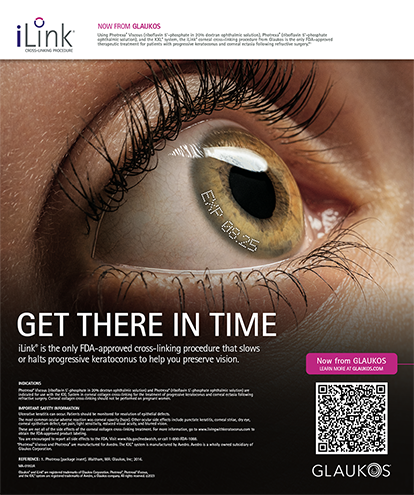Roughly 7 or 8 years ago, I decided to undergo LASIK. My decision was based on a combination of factors. I was mentally prepared to have the procedure, because I wanted the convenience of not having to wear spectacles; this was the biggest reason for my decision. In addition, I was performing the procedure in my practice and thought it was difficult to advocate LASIK for qualified candidates if I did not consider the procedure for myself. This article describes my experience as a LASIK patient.
MY PROCEDURE AND IMMEDIATE POSTOPERATIVE EXPERIENCE
I chose Stephen Slade, MD, of Houston as my surgeon, because he taught me how to perform LASIK in 1996. I underwent the preoperative workup, however, at my own facility in St. Paul, Minnesota. I sent all of the necessary paperwork and data to Dr. Slade. Preoperatively, my refraction was -7.00 2.00 X180 in each eye with 20/20 acuity.
I underwent the procedure on a Friday, late the afternoon. I actually worked most of the day prior to flying to Houston. At his office, Dr. Slade and I examined the results of my preoperative testing to make sure we had the same plan for my surgery and postoperative outcome. Dr. Slade's technician was also present in the laser area of the facility. My LASIK procedure was uncomplicated, and Dr. Slade and I left shortly after surgery to meet Douglas Koch, MD, for dinner.
On the way to the restaurant, I wore eye shields. My eyes watered and felt mildly-to-moderately uncomfortable. After we ordered our drinks and some appetizers, our attention turned to the choice of entrees. Rather than a bound paper menu, a blackboard on the other side of the restaurant from where we were seated presented a list of dinner options. I accused Dr. Slade of planning this setup in order to test my postoperative results. As time passed, I could read the menu, which was located approximately 20 feet from our table.
I stayed the night at Dr. Koch's home. My postoperative appointment with Dr. Slade was fairly early the next morning. During the drive to his office, I was amazed by the clarity with which I saw stop signs, trees, and flowers. My UCVA was 20/25 OU. After the appointment, I flew back to St. Paul and returned to work on Monday, 3 days postoperatively. I recommended performinmg the surgery 5 days following the procedure.
STATISFACTION WITH DECISION AND OUTCOME
I am 100 satisfied with both my decision to undergo LASIK and my postoperative results. I have not required any sort of surgical enhancement. I have developed some presbyopia since having LASIK, however, so I now use reading glasses. I do not have perfect vision, but this is not a reflection on my surgeon. My vision remains in the 20/25 range, which is what I call the dirty 20/20 range. Preoperatively, my vision was worse than 20/400 uncorrected.
My contrast sensitivity is worse since undergoing LASIK. On sunny days, I see very well, but I notice a distinct decrease in my contrast sensitivity when the skies are overcast. I have minimal halos and glare, and my decrease in contrast does not affect my ability to perform surgery.
DRY EYE
I experience mild dry eye periodically, but I do not consider the problem bothersome enough to merit regular treatment. This dry condition has not changed significantly from the third month postoperatively. I keep artificial tears handy at all times, especially when I travel on an airplane. On average, I use artificial tears a couple of times a day, three or four times a week. Occasionally, I wake in the morning with symptoms of dry eye. The problem also occurs when I work late. If necessary, I will use a topical steroid to make my eyes more comfortable when they are feeling particularly dry.
CLOSING COMMENTS
I would undergo the procedure again without hesitation. Moreover, I have performed LASIK on fellow physicians, family members and friends who are all as happy as I am.
By having LASIK, I believe I have brought greater credibility to the discussions I have with patients at my practice regarding their refractive surgery options. Patients and my staff see that I stand behind the procedure. As a result, almost all of my staff members who have worn glasses have undergone LASIK. Their surgery further enriches my practice, because these employees become advocates for the procedure as they discuss options with potential LASIK candidates.
Stephen S. Lane, MD, is a clinical professor at the University of Minnesota in St. Paul. Dr. Lane may be reached at (651) 275-3000; sslane@associatedeyecare.com.


